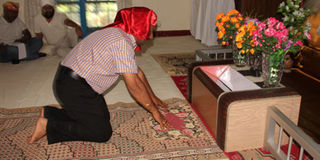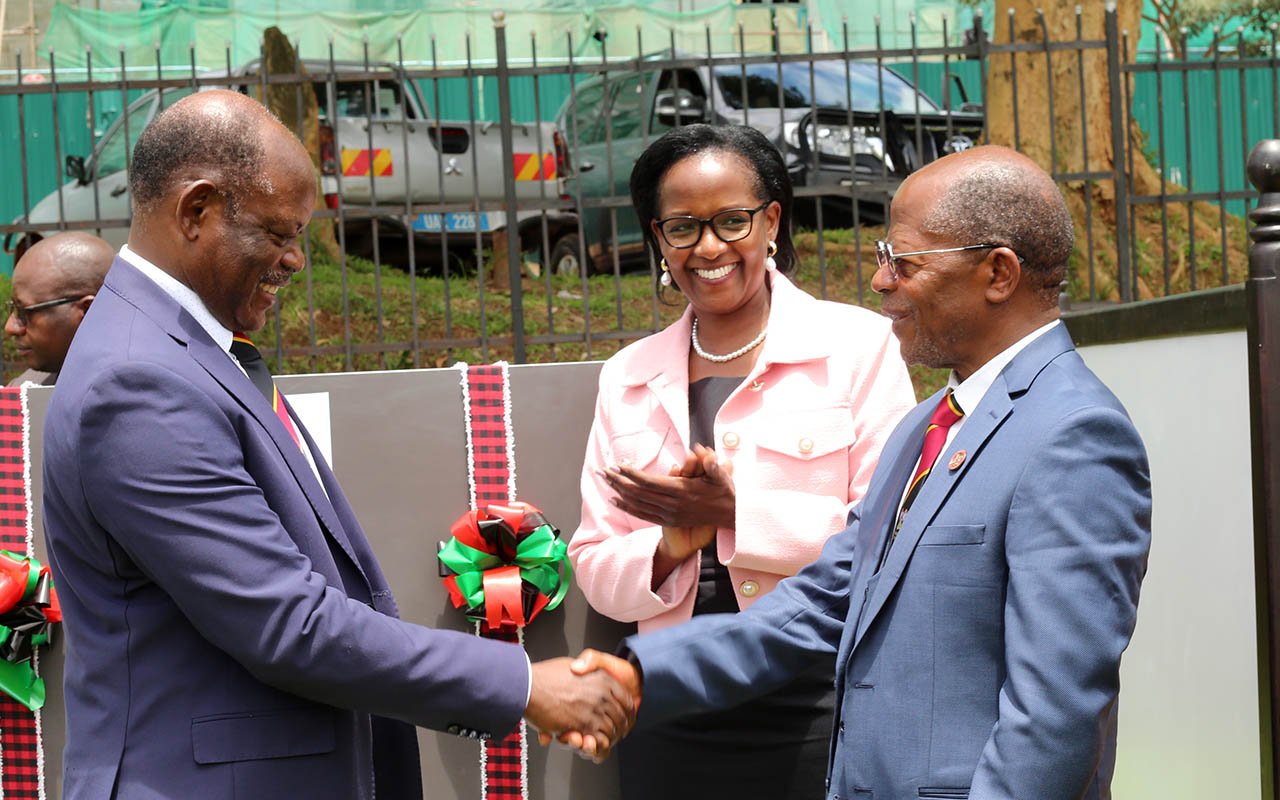What it means to Be Sikh

A worshipper in the temple praying.
What you need to know:
You could have seen them but may not know them. Yet they are an integral part of the country’s history. The Sikhs have been part of Uganda’s society from as far back as the colonial era, writes
Abdulaziizi K. Tumusiime.
Tracing the genesis of the Sikh Community is to go beyond 120 years into the history of East Africa. They originated from Punjabi in Northern India. The first batch of Sikhs to arrive in the region, according to Justice Anup Singh Choudry, were soldiers brought by the Imperial British East African Company (IBEACo) in the 1880s to serve in the police force.
These provided security for the company’s premises and stores. They were also sent to protect the East African railway under construction and the caravan routes to the mainland.
Members of the community talked to were not sure of the exact date when the first Sikhs reached Uganda and their identity. However, they all concurred that by 1900 there were Sikhs in Uganda.
This is buttressed by evidence that the first Sikh temple (Ramgharai Sikh Temple) in Nakivubo was built in 1910. It was a temporary structure. Temples (named Gurdwaras in Punjab) were icons of their presence in the different towns in the country. Soroti, Fortportal, Tororo, Jinja, Mbarara and Mbale are some of the districts in which such temples sit.
Back then
In their maiden years in Uganda, the Sikhs gained popularity for their prowess in building and carpentry, says Parminder Singh Katongole, deputy treasurer of NRM. “Any Ugandan builder or carpenter, who learnt the craft between 1940 and the 1970s, is likely to have learnt from the Sikh,” he states.
The Sikhs also thrived in other disciplines such as; politics, business, sports and security.
In Mbarara District, the mark of the Sikh’s impact takes the form of a street and market named after one of their own; Markhan Singh, a successful Sikh businessman that operated from the district. Singh dealt in long haul transport services. At the height of his business he owned about 100 trucks and employed 400 Ugandans.
Sardar Singh Gupta (SS Gupta) was another prosperous Sikh businessman who lived in the district. He doubled as a board member in a number of schools in Mbarara such as Ntare School, Nyamitanga Muslim School and the Church Missionary Society School.
Current status of the community
The setting of the Sikh community has not changed much. Katongole says there are more than 800 Sikh families in the country. They are no longer active in the Police Force and national sports, but they are vibrant in business, politics and the judiciary. They are more pronounced in the fabrication and long haul transport businesses.
Many a Ugandan can only identify a Sikh by their beard and turban. And when the Sikh’s name is unknown to the Ugandan, the latter will likely invoke the former’s moniker, Singha Singha.
How did the name Singha Singha come about? The origin is not clear. “But one would assume it is derived from Singh, the name of every male Sikh. The Swahili pronounce it as Sing-ha. Thus Singha Singha applies to the whole male Sikh community,” explains Justice Choudry.
The turban and beard show respect of Sikhism (the Sikh religion) says N.P Singh, the Secretary General of Sikh Association of Uganda.
The Sikh etiquette
When a Sikh is baptised, he is referred as Khalsa, meaning, The Pure. A Khalsa is expected to follow the Sikh code of conduct and wear prescribed physical articles of the faith. One of them is never to cut their hair and the beard. The hair is required to be under the turban.
“A Khalsa also has to carry a wooden comb to properly groom their hair. This is a symbol of cleanliness. They are supposed to don specially made cotton underwear as a reminder of the commitment to purity,” explains the Secretary General. “A steel bangle signifying bondage to truth and a ceremonial sword are the other two physical articles we wear.”
N.P Singh notes, Sikhs, especially the young generation, find difficulty in their bid to live by the Sikh code of conduct. They have to bear explaining themselves over and again, why they do not cut their hair. The adults are not spared. Some have been labelled Osama Bin Laden (the fallen leader of Al –Qaeda) because of their long beards.
The turban, steel bangle and Punjabi, the Sikh language, are the distinct features of the Sikhs from the rest of the Asian community. The Sikhs, also, do not worship idols.
In a Sikh home
When a Sikh is born, the Holy Book is randomly opened and the child is named after the first letter, on the first verse of the random page. For example, if the letter is P the child is given a name that begins with letter P, if the letter is A, their name has to start with A.
Besides the chosen name, all males, in Sikhism, have to take the name Singh while the females take the name Kaur.
At around seven years, the children are deemed capable of taking care of themselves, more so, their hair. They are perceived as needless of their mothers’ help to keep their hair clean. So they are baptised and hence forth, the males start enveloping their hair.
Sikhism does not permit polygamy thus marriage is only monogamous, says N.P Singh. He adds; “Intermarriages are permitted as long as the non-Sikh bride or groom commits themselves to the Sikh religion.”
Rituals
The Sikh marriage ceremony is called “Anand Karaj”, meaning “blissful union”. It involves singing four hymns while the bride and groom walk around the Holy Book four times. The action represents the four stages of love. The hymns describe the development of marital love between husband and wife, while simultaneously signifying the love and longing of the human soul for god.
A Sikh husband and wife have varying responsibilities. “The husband has to protect and provide for his family. He has to ensure that at no point should his family depend on any other person than him.
He has to ensure that it lives by the teachings of Sikhism,” says the General Secretary of the Sikh Association of Uganda. “The wife has to nurture the children morally. She is allowed to work in order to be in a better position in the instance of her husband’s death.”
The fundamentals of their cuisine are wheat and vegetables. “We eat a lot of Chapattis and spinach- like leaves,” says Satnam Kaur, a Sikh wife. The Sikhs cremate the dead because once the soul has left the body, they believe the body is of no importance.
They sprinkle the remains of ash into a flowing river to give the remains of the body back to nature. In Uganda, after cremation, the ashes are dumped into The River Nile.
They had been around this long, it was overdue that the Sikhs would not just be seen, but also known.
What is Sikhism?
The Sikh religion is one of the youngest in the world. It is barely 500 years old. It was founded by Guru Nanak. “Guru Nanak spread the message that we are all one and we were created by one God,” says Gyani Manjeel Singh, a Sikh priest adding: “Sikhism emphasises the importance of a number of values, such as, equality of mankind, earning from one’s sweat, meditation and sharing the fruits of one’s labour.”
A visit to the temple in Entebbe got us to appreciate the practice of the above principles. The temple is open to folk from all walks of life. One only has to ensure their head is covered, free of intoxicants and has no shoes on. Worshippers sit facing the direction of the Holy Book called the Siri Guru Granth Sahib.
The book is accorded the status of being the spiritual head of the Sikhs. It has 1,430 pages. Manjeel says it contains all the wisdom needed by Sikhs in the spiritual guidance of their lives.
When worshippers enter the temple, they bow to the religious book. They then draw closer, drop their tithe in a wooden box and go ahead to prostrate before the book. Sikhs are barred from prostrating before anyone and anything but the Holy book.
Sikh families usually have special prayer rooms. They are permitted to have the holy book but have to satisfy strict conditions, like; having no meat in the home (they have to be vegetarians), the house must be free of intoxicants and the prayer room must be clean.
Sunday is when many Sikhs conduct their prayers from the temples. On the day, the temples are more than centres of prayer; they are also an opportunity for families to catch up and have a good chat.
At the end of the prayer session (usually at midday) a community meal called Langa is served. The idea of Langa is to emphasise social equality and sharing per the teachings of Sikhism.
They also meet later in the evening to play cricket or hockey, their favourite sports.




